Quiz Answer Key and Fun Facts
1. We have all heard of many different types of clouds. What is the name of the cloud that is sometimes referred to as the mother-of-pearl cloud?
2. Fog is a cloud which is low-lying and on the ground, no matter the altitude of the ground you are on. Driving in foggy conditions is difficult. What should you NOT do when driving in foggy conditions?
3. Some clouds produce a kind of halo effect around the sun or the moon. The halo is a result of refraction of light by the ice crystals in the clouds. Cirrostratus clouds produce this effect. Do you know how to identify the cirrostratus cloud?
4. We all listen to the weather stations on television. We hear the weatherperson mention the jet stream. What exactly is a jet stream?
5. A pileus cloud is a small, horizontal cloud, smooth and cap-like in appearance. Do you know what the word pileus means?
6. Mid-level clouds, like the altocumulus cloud, usually appear between 2,000 to 6,000 meters (6,500 to 20,000 feet). Since their altitude is lower they are composed mostly of water droplets, but can also have ice crystals when the temperature is cold enough. When you see these clouds, what sort of weather has the possibility to arise?
7. Winds and storms can produce clouds as a precursor to possible tornadoes. Do you know what these clouds are called?
8. There are other types of clouds that are both interesting and odd. Do you know what contrails look like?
9. The earth's topography can force air up and create clouds. An example of the topography that can cause this is mountains. What are these types of clouds called?
10. There is no need to look to the sky to see a cloud. You can make one yourself. Which item is not necessary in order to create your own cloud?
Source: Author
funnytrivianna
This quiz was reviewed by FunTrivia editor
crisw before going online.
Any errors found in FunTrivia content are routinely corrected through our feedback system.

